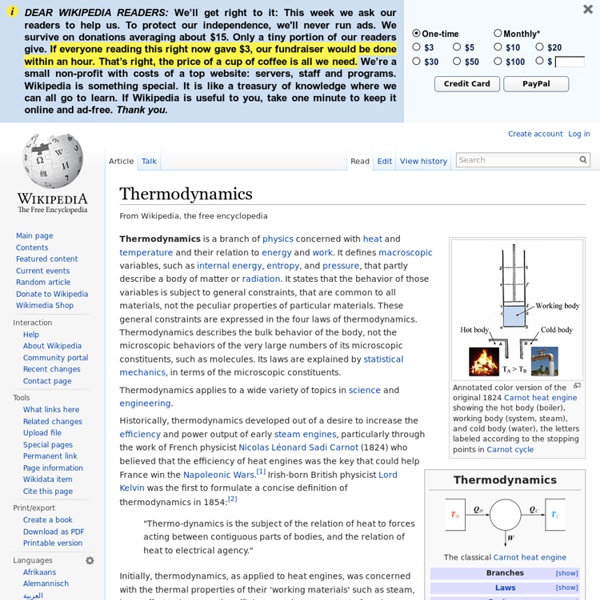Thermodynamics

Statistical mechanics
Statistical mechanics is a branch of mathematical physics that studies, using probability theory, the average behaviour of a mechanical system where the state of the system is uncertain.[1][2][3][note 1] The present understanding of the universe indicates that its fundamental laws are mechanical in nature, and that all physical systems are therefore governed by mechanical laws at a microscopic level. These laws are precise equations of motion that map any given initial state to a corresponding future state at a later time. There is however a disconnection between these laws and everyday life experiences, as we do not find it necessary (nor easy) to know exactly at a microscopic level the simultaneous positions and velocities of each molecule while carrying out processes at the human scale (for example, when performing a chemical reaction). A common use of statistical mechanics is in explaining the thermodynamic behaviour of large systems. Principles: mechanics and ensembles[edit]
Theory of relativity
The theory of relativity, or simply relativity in physics, usually encompasses two theories by Albert Einstein: special relativity and general relativity.[1] Concepts introduced by the theories of relativity include: Measurements of various quantities are relative to the velocities of observers. The term "theory of relativity" was based on the expression "relative theory" (German: Relativtheorie) used in 1906 by Max Planck, who emphasized how the theory uses the principle of relativity. Scope[edit] The theory of relativity transformed theoretical physics and astronomy during the 20th century. In the field of physics, relativity improved the science of elementary particles and their fundamental interactions, along with ushering in the nuclear age. Two-theory view[edit] The theory of relativity was representative of more than a single new physical theory. Third, special relativity was accepted in the physics community by 1920. On the theory of relativity[edit] Special relativity[edit]
Classical mechanics
Diagram of orbital motion of a satellite around the earth, showing perpendicular velocity and acceleration (force) vectors. In physics, classical mechanics and quantum mechanics are the two major sub-fields of mechanics. Classical mechanics is concerned with the set of physical laws describing the motion of bodies under the action of a system of forces. The study of the motion of bodies is an ancient one, making classical mechanics one of the oldest and largest subjects in science, engineering and technology. It is also widely known as Newtonian mechanics. The term classical mechanics was coined in the early 20th century to describe the system of physics begun by Isaac Newton and many contemporary 17th century natural philosophers, building upon the earlier astronomical theories of Johannes Kepler, which in turn were based on the precise observations of Tycho Brahe and the studies of terrestrial projectile motion of Galileo. History[edit] Description of the theory[edit] Similarly,
Quantum mechanics
Description of physical properties at the atomic and subatomic scale Quantum mechanics is the fundamental physical theory that describes the behavior of matter and of light; its unusual characteristics typically occur at and below the scale of atoms.[2]: 1.1 It is the foundation of all quantum physics, which includes quantum chemistry, quantum field theory, quantum technology, and quantum information science. Quantum mechanics can describe many systems that classical physics cannot. Classical physics can describe many aspects of nature at an ordinary (macroscopic and (optical) microscopic) scale, but is not sufficient for describing them at very small submicroscopic (atomic and subatomic) scales. Overview and fundamental concepts Quantum mechanics allows the calculation of properties and behaviour of physical systems. A fundamental feature of the theory is that it usually cannot predict with certainty what will happen, but only gives probabilities. Mathematical formulation . and , where Here
Related:
Related:



